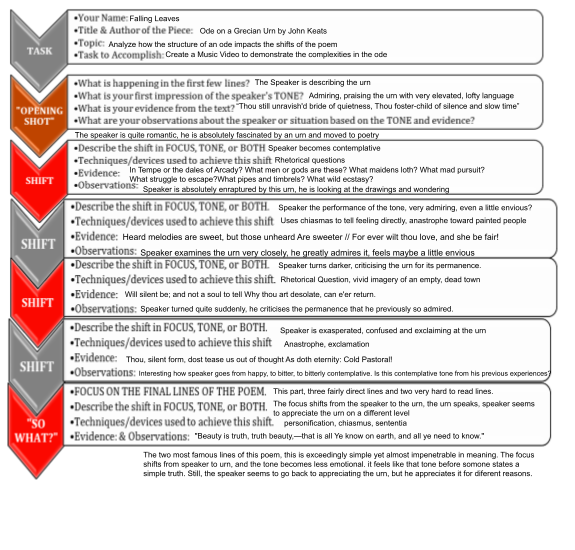
Poetry Project Reflection: Ode on a Grecian Urn, by John Keats
In our first full project as a group (the Falling Leaves), we created a performance music video to better understand the inherent nuances in classic forms of poetry. In these videos, we made choices regarding the visual elements, music, and reading of the poem the we felt best reflected our interpretation of the shifts and purpose of the form. After beginning research on the ode form, we quickly found that this project was not as simple as putting a dramatic reading of the poem to some music.
While the Ode itself dates back to ancient Greece, John Keats used a modified version heavily inspired by sonnet-form to maintain the appreciation of a single object or idea while adding his own stylistic touches to the actual writing of the piece. Similar to "Yellow," by Coldplay, our style inspiration for this project, Keats speaks directly to the object, the urn, about which he speaks. His use of apostrophe is a defining characteristic of this ode and when Keats finishes speaking to the urn in the last two lines, the inanimate object to which Keats was chatting metaphorically speaks, leaving the reader with two of the most widely debated lines between scholars of poetry. While it was difficult to fully understand the ambiguous nature of these lines and other parts of the poem, by pushing ourselves to develop our own understanding, meaning, and interpretation of the poem before looking for outside resources, Alex, Alex, Dan, and I forced ourselves to make bolder conclusions in our analysis and interpretation of the text. While this was frustrating at first for some of us, taking a step back allowed us to focus less on what the "correct" answer is and more on what "an" answer is. Upon later cross-examination, we found that the meanings we found in Keats' writing lined up well with those devised by experts in the field. What we relied on mostly for this conclusion were the tone shifts (specifically the Strophe, Anti-strope, and epode in an ode), the literary devices used, and historical context surrounding Keats' writing of the poem. We dissected and looked-over these elements very closely, but by working in a group, we were all able to add little bits of the poem's meaning to the incomplete puzzle that we are all able to make on our own.
I was also surprised in my group's ability synthesis these smaller elements and stay organized in the process; Maybe it was the 12 google docs, but given the time restrictions we all had over the course of this project, I think we handled such an involved task well. Specifically, we didn't have time to film either in class or outside of school, but we were able to all record our respective parts in a certain space in our homes. This actually fit well with our stylistic choices, as we were going to have the listener, "the urn" follow around various speakers through the poem. I know that by the next project, I want to have everything finished about one day sooner to give use time to run through the presentation and make sure it is coherent, clear, and clever.

No comments:
Post a Comment